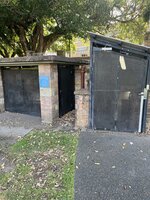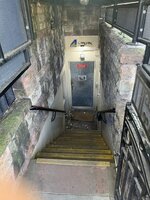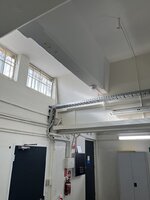bilby
Fair dinkum thinkum
- Joined
- Mar 6, 2007
- Messages
- 33,979
- Gender
- He/Him
- Basic Beliefs
- Strong Atheist
In WWII, fearing Japanese air raids, a number of bomb shelters were constructed in Brisbane.
Many of these were built for public use, and were fairly flimsy - they had a concrete roof, and cinder-block walls, and were specifically designed to serve as tram shelters (once the walls were removed) after the war.
However, General MacArthur had a more robust below ground shelter for his senior staff, which was built at what is now Centenary Place. His HQ buildings were just on the opposite side of Ann Street, so the shelter would have been readily accessible in the event of an air raid warning.
In the 1960s, the majority of the ground-level public shelters were demolished, but one was kept as a storage shed for the groundskeepers; The underground military shelter was converted to a meal room and toilet facility for council tram and bus drivers.
So this morning, I used General MacArthur's lavatory.
This is the entrance to the underground shelter, and to the left, the old "tram shelter" style public shelter. You can see the recess at the edge of the concrete roof where the walls used to be:

The above ground public shelters were really only good to protect against falling shrapnel and fairly distant bombs; Even when covered with a layer of earth and surrounded by sandbags, they wouldn't have done much against a direct hit.
Access to the underground shelter is via a steep flight of steps:

Down in the underground shelter, you can still see how seriously solid the roof and its concrete supports are:

Some small windows have been cut out at the modern ground level:

Apart from bus drivers, very few people in Brisbane are aware that this little piece of wartime history is even there. The Queensland government website says that the shelters here were demolished in the 1960s, and Wikipedia echoes that statement, but in reality a significant portion remains in place (albeit with major modifications), largely because it would have been a massive effort to completely demolish such a structure.
It's all tucked away in the small park in the angle between Wickham and Ann Streets, which are amongst the busiest roads in the city, but it's disappeared almost completely from the public record, and from local knowledge.

The blue plaque gives a brief history of Captain John Wickham, for whom Wickham Street is named; It says nothing at all about the WWII bomb shelter to which it has been affixed.
What little known historical remnants are found in your home towns?
Many of these were built for public use, and were fairly flimsy - they had a concrete roof, and cinder-block walls, and were specifically designed to serve as tram shelters (once the walls were removed) after the war.
However, General MacArthur had a more robust below ground shelter for his senior staff, which was built at what is now Centenary Place. His HQ buildings were just on the opposite side of Ann Street, so the shelter would have been readily accessible in the event of an air raid warning.
In the 1960s, the majority of the ground-level public shelters were demolished, but one was kept as a storage shed for the groundskeepers; The underground military shelter was converted to a meal room and toilet facility for council tram and bus drivers.
So this morning, I used General MacArthur's lavatory.
This is the entrance to the underground shelter, and to the left, the old "tram shelter" style public shelter. You can see the recess at the edge of the concrete roof where the walls used to be:

The above ground public shelters were really only good to protect against falling shrapnel and fairly distant bombs; Even when covered with a layer of earth and surrounded by sandbags, they wouldn't have done much against a direct hit.
Access to the underground shelter is via a steep flight of steps:

Down in the underground shelter, you can still see how seriously solid the roof and its concrete supports are:

Some small windows have been cut out at the modern ground level:

Apart from bus drivers, very few people in Brisbane are aware that this little piece of wartime history is even there. The Queensland government website says that the shelters here were demolished in the 1960s, and Wikipedia echoes that statement, but in reality a significant portion remains in place (albeit with major modifications), largely because it would have been a massive effort to completely demolish such a structure.
It's all tucked away in the small park in the angle between Wickham and Ann Streets, which are amongst the busiest roads in the city, but it's disappeared almost completely from the public record, and from local knowledge.

The blue plaque gives a brief history of Captain John Wickham, for whom Wickham Street is named; It says nothing at all about the WWII bomb shelter to which it has been affixed.
What little known historical remnants are found in your home towns?
